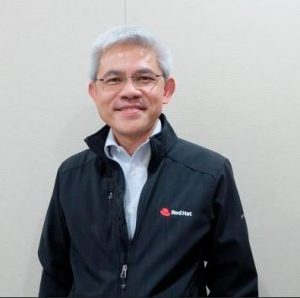
Written By: Francis Chow, Vice President and General Manager, Red Hat In-Vehicle Operating System and Edge, Red Hat
Our lives are inextricably linked with technology. We talk about our cell phones (and our relationships with them) all the time. Now we’ve got smart appliances, household cameras, banking, and telehealth . . . The list goes on and on. Automotive must be part of this too, right? Open source will help transform it in ways we never could’ve imagined.
We’ve seen smart cars but this only scratches the surface. The automotive industry is deeply intertwined with our daily lives but its software advancements pale in comparison to other key pieces of our daily personal ecosystems.

Francis Chow, Vice President and General Manager, Red Hat In-Vehicle Operating System and Edge, Red Hat
And we know it’s not a perfect 1:1 comparison. While irritating, your smart refrigerator malfunctioning doesn’t rise to the same level as your car doing the same. Vehicles are complex to build and safety is critical. But we believe there are countless opportunities where Red Hat can help move the industry forward.
Back in 2011, Andreessen Horowitz famously said, “Software is eating the world.” In the past 13 years, we’ve witnessed tremendous transformations across the globe, in every industry. When you abstract hardware from software, and provide APIs to each layer of technology, suddenly innovation can move at breakneck pace.
During this time we’ve also witnessed just how impactful a collaborative, open source model can be in driving value. Open source isn’t just about opening up our code; it’s more so about free-flowing collaboration—without boundaries of companies, industries, and physical borders.
Open Source in the Automotive Industry
We’ve seen a lot of talk about open source for the automotive industry, but we want to take it further than it is now. Specifically, we want to take it right to the safety critical systems at the heart of software-defined vehicles (SDVs).
It’s like the venture capital world, right? Everyone is waiting for someone else to jump in first because they usually will. But at Red Hat, we’re jumping all the way in. Our 25+ years of history and experience supporting mission-critical applications in airlines, banks, and hospitals, which require no less quality, reliability and security, gives us confidence that we can do it.
Since embarking on this journey, we’ve learned a lot and we’re thrilled that we’re seeing automotive industry leaders using our edge and AI-enabled solutions and leaning on our open source experience. Red Hat is teaming up with these key industry players to help fast-track SDV concepts into the market, backed by our edge expertise and new pre-tested and pre-integrated solutions all running on Red Hat-In Vehicle Operating System.
At Red Hat Summit 2024, I was pleased to talk about a few of these stories.
Pre-Tested, Pre-Integrated Software Solutions
We’ve been excited to share news with multiple industry leaders to help drive automotive innovation with open source. With Deloitte, we’re helping customers and partners address escalating software complexity and quality risks for automakers and suppliers with a broad solution to assist in the design, operations and management of SDVs. This move provides the automotive industry with greater choice and flexibility.
With Renesas, we’re collaborating to build an open, flexible compute platform where Red Hat In-Vehicle Operating System will be enabled in current and future generations of R-car solutions, empowering customers with end-to-end open-car compute solutions for SDVs.
This is especially meaningful as Renesas is embracing open source principals and contributing to upstream communities, helping to bolster industry-wide collaboration. This, in turn, fosters a culture of transparency and accessibility, a necessity for driving future advancements in automotive technology.
By working within our ecosystem to deliver these pre-tested, pre-integrated software solutions, Red Hat is helping accelerate the pathway to smarter vehicles.
Shifting Gears with AI at the Edge
Earlier I mentioned that we haven’t even begun to scratch the surface of what we can do with vehicles. Now that we’ve talked about how to get there, let’s talk about what this will look like.
We announced that we’re working with Qualcomm Technologies and the Snapdragon Ride Flex system-on-chip (SoC) to showcase a complete end-to-end development and deployment of microservices-based advanced driver assistance systems (ADAS) applications with a demo at Red Hat Summit.
The Snapdragon Ride Flex SoC, with its pre-integrated hardware and software support for computer vision and AI, enables the development and deployment of ADAS applications. In the demo, the operator can invoke a retraining of the AI object detection model to recognise traffic lights, validated in the cloud emulation environment, and then deployed to the vehicle instance in the booth.
“In the past 13 years, we’ve witnessed tremendous transformations across the globe, in every industry. When you abstract hardware from software, and provide APIs to each layer of technology, suddenly innovation can move at breakneck pace. During this time we’ve also witnessed just how impactful a collaborative, open source model can be in driving value. Open source isn’t just about opening up our code; it’s more so about free-flowing collaboration—without boundaries of companies, industries, and physical borders.”
The seamless workflow is supported by a cloud-native automation software development process, which includes virtual platform simulation that can be integrated as part of in-cloud development operations (DevOps) and machine learning (MLOps) infrastructure.
With this work, automakers will be able to better prototype software fixes, new features and revenue-generating services in the cloud before deployment to the car. They will then have the ability to deploy software updates to a factory test lab or directly to the vehicle in-service within mere minutes.
With the Snapdragon Ride Flex SoC’s ability to support digital cockpit, ADAS, and automated driving capabilities on a single platform, automakers can feature generative AI capabilities, high-end graphic, gaming displays, and rear entertainment screens concurrently with latency-critical audio experiences.
With this, AI chatbots in the car to help interact with drivers through voice, local mapping, predictive maintenance, ADAS, traffic management and more. All of these use cases are in some way using AI at the edge by bringing AI algorithms and data analytics closer to the source of data generation, in the car itself, for faster decision-making and reducing reliance on external networks.
In SDVs, various sensors collect massive amounts of data from the vehicle’s surroundings, including information about road conditions, traffic patterns, pedestrian movement, and vehicle performance. AI algorithms deployed at the edge process this data in real time to extract actionable insights and make autonomous driving decisions, enhance safety features, optimize vehicle performance and provide personalized in-car experiences for passengers.
Navigating Security and Compliance for a Functionally Safe Linux
SDVs have brought upon a paradigm shift. And amidst this revolution, it’s important to also drive robust security and compliance measures. As SDVs become increasingly interconnected and reliant on complex software ecosystems, the vulnerability to cyber threats escalates exponentially.
Moreover, regulatory bodies and industry standards demand stringent adherence to compliance frameworks to safeguard user privacy, data integrity, and overall road safety. Multiple automotive applications, including digital cockpit and ADAS, typically require functional safety certification using ISO26262. Thus, establishing comprehensive security protocols and upholding regulatory compliance is paramount to realising the full potential of SDVs while fostering trust among consumers and stakeholders alike.
With the advent of modern in-car compute architectures leveraging central compute and zonal controllers, automakers are consolidating multiple functions on a single SoC. With this, Linux becomes an attractive option for more automotive applications employing modern architectures, but the lack of compliance with functional safety standards presents adoption challenges.
Previously, safety certification has strongly favored a traditional waterfall-like development paradigm whereas Linux employs a community-based, agile, open source model.
Red Hat is continuing to work with exida to develop a tailored approach to functional safety, one that emphasizes Linux strengths while still achieving the risk management objectives of ISO26262.
In our work with exida, we have been able to make significant progress and are on track to meet our goal of achieving ISO 26262 v2 certification of Red Hat In-Vehicle Operating System at ASIL-B as a Safety Element out of Context (SEooC), enabling broad adoption of Linux to host safety-critical workloads along with non-safety workloads on the same OS.
 (0)
(0) (0)
(0)Archive
- October 2024(44)
- September 2024(94)
- August 2024(100)
- July 2024(99)
- June 2024(126)
- May 2024(155)
- April 2024(123)
- March 2024(112)
- February 2024(109)
- January 2024(95)
- December 2023(56)
- November 2023(86)
- October 2023(97)
- September 2023(89)
- August 2023(101)
- July 2023(104)
- June 2023(113)
- May 2023(103)
- April 2023(93)
- March 2023(129)
- February 2023(77)
- January 2023(91)
- December 2022(90)
- November 2022(125)
- October 2022(117)
- September 2022(137)
- August 2022(119)
- July 2022(99)
- June 2022(128)
- May 2022(112)
- April 2022(108)
- March 2022(121)
- February 2022(93)
- January 2022(110)
- December 2021(92)
- November 2021(107)
- October 2021(101)
- September 2021(81)
- August 2021(74)
- July 2021(78)
- June 2021(92)
- May 2021(67)
- April 2021(79)
- March 2021(79)
- February 2021(58)
- January 2021(55)
- December 2020(56)
- November 2020(59)
- October 2020(78)
- September 2020(72)
- August 2020(64)
- July 2020(71)
- June 2020(74)
- May 2020(50)
- April 2020(71)
- March 2020(71)
- February 2020(58)
- January 2020(62)
- December 2019(57)
- November 2019(64)
- October 2019(25)
- September 2019(24)
- August 2019(14)
- July 2019(23)
- June 2019(54)
- May 2019(82)
- April 2019(76)
- March 2019(71)
- February 2019(67)
- January 2019(75)
- December 2018(44)
- November 2018(47)
- October 2018(74)
- September 2018(54)
- August 2018(61)
- July 2018(72)
- June 2018(62)
- May 2018(62)
- April 2018(73)
- March 2018(76)
- February 2018(8)
- January 2018(7)
- December 2017(6)
- November 2017(8)
- October 2017(3)
- September 2017(4)
- August 2017(4)
- July 2017(2)
- June 2017(5)
- May 2017(6)
- April 2017(11)
- March 2017(8)
- February 2017(16)
- January 2017(10)
- December 2016(12)
- November 2016(20)
- October 2016(7)
- September 2016(102)
- August 2016(168)
- July 2016(141)
- June 2016(149)
- May 2016(117)
- April 2016(59)
- March 2016(85)
- February 2016(153)
- December 2015(150)
